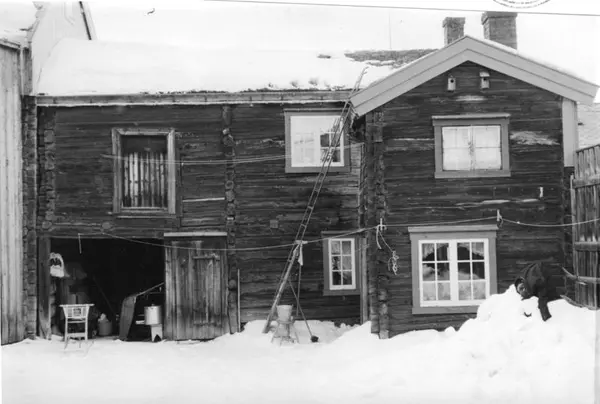-
Rasmusgården 1975. Photo: Sverre Ødegaard. Rørosmuseet
Randi Borgos
Most of the houses had some considerable distance between the houses and the land that belonged to them and this affected the management. Among other things the transportation of manure and feed was more demanding. There was a lot of backwards and forwards during haymaking because the fields were in different places around the town. Similarly, the way in which the houses were packed together at that time limited the possibility of changing or building on, even if they wanted to. This meant that the method of husbandry and farming continued more or less unchanged as long as animals were kept.
Agriculture in Røros was in the main womens’ farming. This applied to the animal husbandry in the properties in town and to the outlying farms. The miners were away down the mine all week, so it was the children and the women who looked after the animals. The men who worked in the smelting house were in a different situation. The ‘shed boys’ (hyttekarene) could stay in their homes and as the smelting work was carried on in shifts there was more time to spend on the farm.
The miners had the right to one month off work in the summer to enable them to harvest the hay and take on other important farm work. During this month off work in the mine closed down. This old right, allowing a worker to take time off in order to complete his harvest was something the miners had to fight for on several occasions.
At the time of mid-summer people moved out of the mining town and went to live in their sheds or cottages in their fields that can best be described as summer farms. These summer farms meant a great deal for the economy of the community and, furthermore, they were also beneficial for the health of the people and the animals. Most of them stayed on the summer farms until about 20t September. Then common grazing was allowed on the planted plots of land in and around the town. This arrangement gave everyone’s animals a fair chance to graze on the lush grass that grew up after the first cutting. The autumn grazing continued for about 14 days and there was a lot going on in Røros during that time. In 1920 the common grazing arrangements were discontinued.
During the time people were up in their summer farms Røros was a forsaken town. This is how things were until after the end of the Second World War. At that time many of the farms were closed down and a new era was coming about with the advent of tourism as a means of livelihood in Røros.
